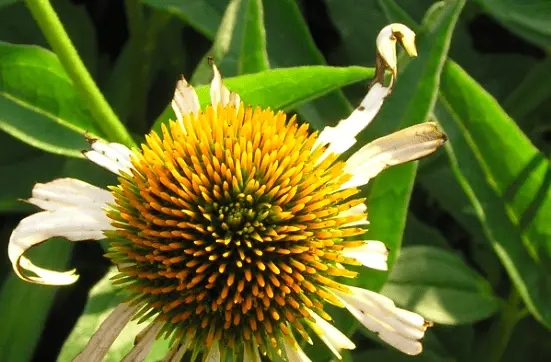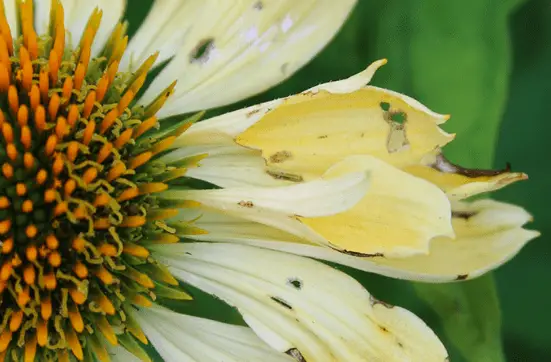Coneflowers are one of my favorite flowers. I love their big, bold petals and the way they seem to hold onto summertime. But despite how wonderful they are, coneflowers are still vulnerable to the same pests and diseases as other flowers. One of the most common problems coneflowers face is holes in their petals.
In this post, I’ll share some of the most common causes of holes in coneflowers and what you can do to prevent them. Let’s get straight into it…
Why Are There Holes in My Coneflowers?
Pests are the most common cause of holes in coneflowers. Aphids, Japanese beetles, and other pests can all cause holes in the petals. Fungal disease can also cause holes, but it is less common than pest damage.
All of these pests love crawling into the nooks and crannies of the flower petals and eating away at them. The holes they leave behind are small, but they can quickly add up and ruin the flower.
Eriophyid mites are one type of mite that is particularly fond of coneflowers. These tiny pests are barely visible to the naked eye, but they can cause a lot of damage. Eriophyid mites live inside developing flower buds, and as the bud opens, the mites are released. They then crawl out and start feeding on the petals.
These holes may seem to appear from nowhere, and this is because the pests are often very small and hard to spot. You may need to take a magnifying glass and have a closer look at your flowers to find the pests.

How to Remove Pests from Coneflowers?
If you do find pests, there are a few things you can do to get rid of them. Bigger pests, like slugs and snails, can be picked off by hand and thrown into soapy water. This will kill them and stop them from coming back.
For smaller pests, like aphids and beetles, you can use a hose to blast them off of the flower. But to stop the pests from returning, you’ll need to use an insecticide.
There are many different types of insecticides, so it’s important to choose one that is specifically designed to kill the pests you have. My favorite type of insecticide is Neem oil, which is made from the neem tree and is safe to use in the garden.
To use neem oil, mix it with water according to the instructions on the bottle. Then, using a spray bottle, generously coat the affected flowers. The neem oil will kill the pests and also prevent them from returning.
How to Prevent Pests From Attacking Coneflowers?
To prevent pests from attacking your flowers, there are a few things you can do. First, make sure to regularly check your flowers for pests and remove them as soon as you see them. Second, keep your garden clean and free of debris where pests can hide.
Third, use a pesticide like neem oil to prevent pests from returning. Doing preventative applications of neem oil will create a barrier that disrupts the life cycle of the pests and prevents them from reproducing.
Finally, think about releasing beneficial insects into your garden. Ladybugs, for example, love to eat aphids and will help keep your flowers safe from them. This is an eco-friendly way to control pests and is also very effective.

Other Possible Causes
There are a few other possible causes of holes in coneflowers, but they are much less common than pests.
Harsh Weather
Harsh weather, like severe winds and hail, can cause holes in the petals. This is because the flowers are hit with large pieces of ice or debris that break through the petals. Wind can also cause petals to tear.
There is not much you can do to prevent this type of damage, but you can try to protect your flowers by covering them with a cloth or tarp when bad weather is forecasted.
Fungal Disease
Fungal disease is another possible cause of holes in coneflowers. Powdery mildew and rust are two common fungal diseases that can affect coneflowers. These diseases cause the petals to turn brown or yellow and eventually develop holes.
To prevent fungal disease, make sure to water your flowers at the base of the plant rather than from above. This will prevent the leaves from getting wet, which can lead to fungal growth. You should also remove any affected leaves from the plant to prevent the disease from spreading.
If you think your flowers have a fungal disease, you can treat them with a fungicide. Be sure to choose a fungicide that is specifically designed for the type of fungus you have.
Animals
While deer tend to ignore coneflowers, other animals like rabbits and groundhogs may nibble on the petals. This can cause holes or ragged edges on the petals.
If you think animals are causing damage to your flowers, you can try putting up a fence around your garden. You can also try using repellents, but be sure to choose one that is safe for use around flowers.
Should I Prune Coneflower Petals with Holes?
There is no need to prune coneflower petals or leaves with holes unless a fungal disease is present. Fungal diseases can spread quickly through a plant, so it’s important to remove any affected parts of the plant as soon as possible.
To prune coneflowers, cut off the affected petals or leaves with a sharp knife or pair of scissors. Make sure to disinfect your tools before cutting to prevent the disease from spreading.
Once you’ve removed the affected parts of the plant, dispose of them in the trash or burn them to prevent the disease from coming back.
Conclusion
In conclusion, holes in coneflowers are usually caused by pests. The best way to prevent holes is to regularly check your flowers for pests and remove them as soon as you see them. You can also use a pesticide like neem oil to prevent pests from returning.
Coneflowers are a beautiful addition to any garden, and I hope this article has helped you troubleshoot the cause of holes in coneflowers. If you have any other questions, feel free to leave a comment below. Thanks for reading!
Tim is an avid gardener from the UK. He was the founder of PlantCarer.com from 2021 to Sep 2023. He sold PlantCarer.com to Aaron. He has since started his own business called Seed To Supper, which provides new gardeners all the materials you need in a box (pots, seeds, compost and instructions) to grow your own delicious and nutritious vegetables and herbs from start to finish – no garden required.









0 Comments